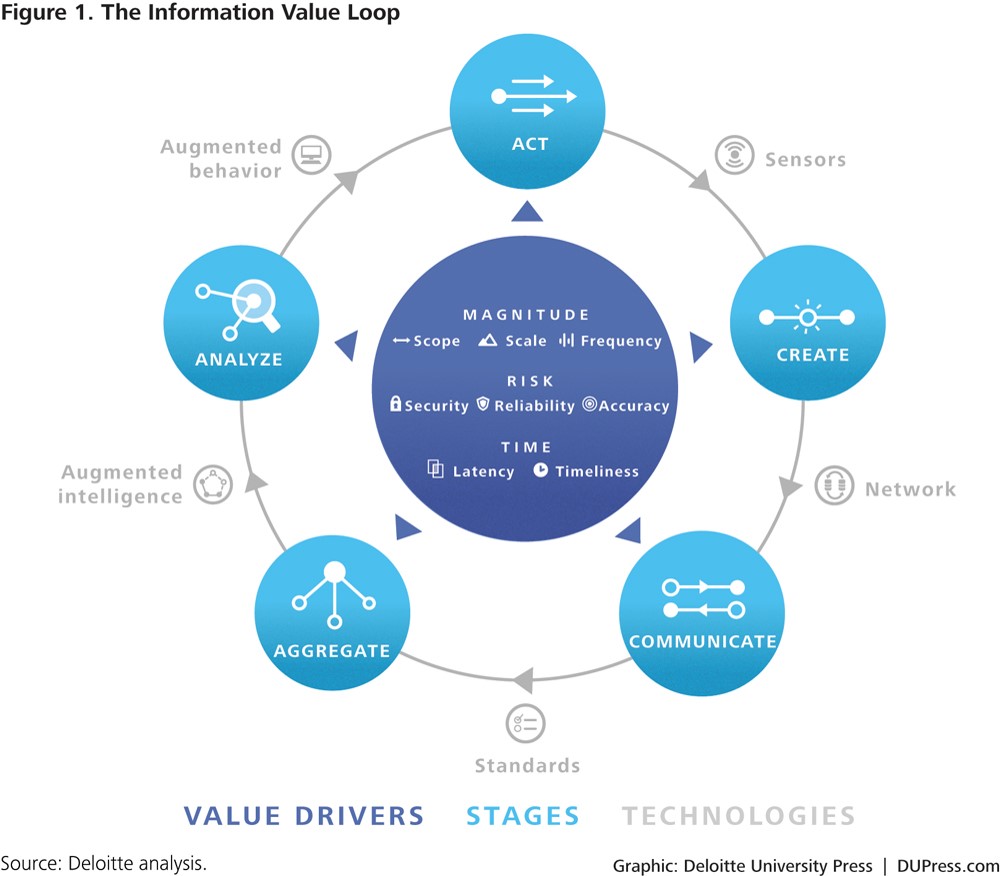Growing IoT platforms: A new way to create value
What makes grass green?
一个简单的问题,有一个复杂的答案。事实证明,植物细胞不能独自刺穿阳光和水。相反,他们需要经纪人的服务,叶绿体,以融合原材料并产生能量。
How do you make money from IoT?
Another simple question with a complex answer, and, like plant cells, the answer may lie in facilitators, or platforms, to support companies in making use of the technological raw materials offered to them.
绿色:平台如何创造价值
了解为什么platform may be necessary for IoT, we need to first understand what IoT is and why companies and consumers might benefit from it. IoT is fundamentally an architecture and not a single technology itself.[一世]也就是说,物联网以特定方式(图1中信息价值循环描述)连接现有技术,以使人们和公司能够完成全新的事物,并为此为他们创造价值。[ii]
但是,鉴于物联网技术的多样性,任何一家公司都不可能在信息价值循环的每个阶段都具有内部所有设备或专业知识。相反,即使是最大的公司也必须从广阔的一系列技术和整合合作伙伴to make relatively simple IoT applications work. Beyond merely the physical sensors, elements as diverse as managing RESTful services,API management或数据分析模型,所有这些模型都必须无缝地融合在一起并首次工作。因此,寻求物联网价值的企业面临的最大挑战之一是协调同时融合在一起所需的许多要素。该协调员可能是一个物联网平台。
A platform is typically a space — physical or virtual — for two parties to meet in order to create value.[一世]More precisely, the platform represents a two-sided market — one where the platform can affect the volume of transactions on one side, while balancing the price paid by the other side. IoT platforms operate in a similar manner. They create value, not by making any specific product, but rather by connecting previously disconnected supply and demand.
Butwhy platforms?为什么不出售任何其他物联网产品或服务?平台成功的秘诀隐藏在供求之间的关系中。如果平台通过提供可以选择的供应和需求选项来创造价值,那么平台提供了更多的解决方案选项,其吸引更多用户。而且它吸引的用户越多,该平台对解决方案开发人员的吸引力就更具吸引力,从而产生了称为正网络效应的飞轮效应(见图2)。我们可以通过使用这种效果来量化这种效果对平台所有者使用Metcalfe’s Law,该原则指出,如果参与者的参与者,网络的价值与广场直接成正比。[ii]因此,合作伙伴生态系统的更广泛参与为所有这些合作伙伴提供了更大的潜在价值,并成倍地做到了!
种下种子:迈向创建物联网平台的第一步
With the potential to create so much value, many companies want to dive in headfirst into creating an IoT platform. While there are obstacles on this journey, there are a number of key factors to consider as you begin building your platform:
- 确定创建价值所需的生态系统合作伙伴。很少有任何单一公司能够提供使解决方案起作用所需的所有技术和专业知识 - 一种ecosystem of partners通常需要使用物联网实现目标。确定该伙伴组是迈向平台开发的关键第一步(见图3)。
- Understand where there are gaps in the vendor ecosystem.In any ecosystem, there will be gaps and imperfect connections between participants. When you know value is created by the flow of information, you will be better positioned to identify where there are gaps or bottlenecks in that flow. Addressing those areas — through partnership, acquisition or development — will be key to creating value.
- Fill that gap.一旦确定了信息流的差距或放缓,潜在平台就必须移动以填补该空白。这将涉及外部活动以将平台与客户和开发人员定位,但几乎肯定还需要新的内部功能。例如,从单个产品过渡到平台的公司可能需要add data scientists,设计思想家,网络安全,隐私专家,它是面向客户的功能,以及专注于捆绑产品的产品经理。
- 竞赛扩展。Finally, survival for many platforms rests with rapidly harnessing the network effect to attract more customers and more developers. This process reaches far beyond mere advertising or marketing, ultimately touching the core of the business. Platforms can capture value unequally from both sides — whether by charging supply, demand or both. Understanding how ecosystem partners assign value to the platform is critical to attracting more stakeholders and achieving positive network effects.
While these factors can seem to be daunting challenges, they are merely part of the process. Just as a plant does not go from seed to tree overnight, there is no need to have every answer at the start. Organizations and ecosystems often use prototyping to learn about the potential of digital platforms. So,think big, 但start small, and thenscale fastthose ideas that prove to be viable. And while the creation of a new platform can be a difficult and daunting process — especially for companies used to selling products — understanding the core principles of platforms can help you turn this technology into a valuable source of business that gets bottom line results.
[一世]Holdowsky,Mahto,Raynor和Cotteleer。Inside the Internet of Things: A primer on the technologies building IoT。德勤大学出版社。2015年8月。
[ii]迈克尔·雷诺(Michael Raynor)和马克·科特勒(Mark Cotteleer)。变化越多:价值创造,价值捕获和物联网。德勤大学出版社。德勤评论问题17. 2015年7月27日。
[iii]Andrei Hagiu and Julian Wright (2011). Multi-Sided Platforms, Harvard Working Paper 12-024.
[iv]詹姆斯·亨德勒(James Hendler)和詹妮弗·戈尔贝克(Jennifer Golbeck)(2008)。Metcalfe’s Law, Web 2.0, and the Semantic Web(PDF).
All IoT Agenda network contributors are responsible for the content and accuracy of their posts. Opinions are of the writers and do not necessarily convey the thoughts of IoT Agenda.



